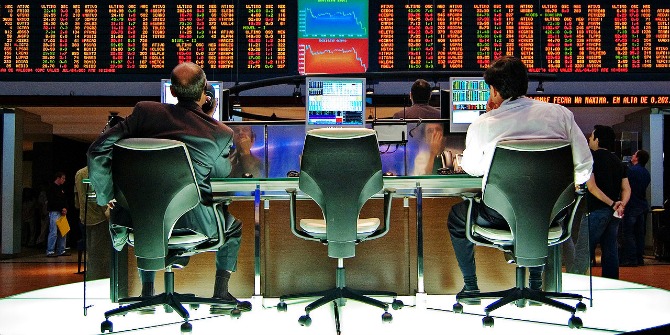
Most of us are familiar with the experience of scouring supermarket shelves to find the items we want at the right price – but how effective are we at converting the time spent looking for a particular product into monetary savings? Our research seeks to measure the benefits of consumer search by studying the behavior of around 12,000 shoppers visiting a large supermarket in Northern California. Our results show that shoppers who search for longer find cheaper products, and are thus rewarded with cost savings.
To avoid interfering with consumers’ normal shopping behavior, we use a unique dataset obtained from radio-frequency identification (RFID) tags attached to supermarket shopping carts. Once consumers pick up a shopping cart (or basket), the RFID tags start to emit signals to a grid of antennas installed on the roof of the supermarket.
We combine the data collected from the RFID tags with purchase data from loyalty cards and a map of the supermarket with the location of all products placed on the shelves. This technology allows us to record consumers’ purchases, the paths they travel within the supermarket as well as the time they spend in front of a shelf when contemplating which product to buy, giving us a direct measure of search effort.
The data collected from the supermarket suggest that consumers spend about 10 seconds on average in the vicinity of the products that they eventually purchase. Using pricing data, we can quantify the possible benefits from searching by reporting the difference between the average and the lowest price we observe in each product category. The average price corresponds to the expected price when the consumer does not engage in search, while the minimum price reflects the expected price paid when search is exhaustive.
We find an average price difference of $1.57, but the difference varies both across and within product categories. On average, consumers buy in seven categories on a shopping trip, which would allow for total trip-level savings of roughly seven times $1.57 or $11. This corresponds to 40 percent of total expenditure during the average shopping trip, which suggests that there are substantial gains from search.
We also find that the impact of extending search is surprisingly large. An additional minute spent searching lowers expenditure by $2.10, which corresponds to about 7 percent of total expenditure on the average shopping trip. This number quantifies how much more consumers could have saved if they extended their search time from the current level, and hence suggests that consumers are not realizing substantial possible gains from further search. This could be either because they find it cumbersome to search or because they are underestimating the possible gains from search.
Perhaps surprisingly, we find that characteristics of different product categories, such as the average price level, have little influence on search behavior. In other words, consumers are searching for similar amounts of time in cheap and expensive categories. There is, however, very substantial variation in search duration across different areas of the supermarket, partly due to the timing of the average visit to those categories. For example, categories that are stocked towards the exit tend to be visited late in the trip and consumers systematically search less in those categories.
These findings suggest that situational factors such as cognitive exhaustion towards the end of a shopping trip are a strong determinant of how much consumers search and hence how likely they are to find a good deal. The supermarket layout can therefore greatly influence purchase decisions via its impact on search behavior. Our findings also imply that because of the limited amount of search that consumers actually do, marketing tools such as feature advertising and in-store displays can be very effective.
♣♣♣
Notes:
- This article appeared on LSE’s USAPP, and was published originally on CentrePiece, the magazine of LSE’s Centre for Economic Performance (CEP). It is based on CEP Discussion Paper No. 1296: ‘Consumer Search: Evidence from Path-tracking Data’.
- The post gives the views of its authors, not the position of LSE Business Review or the London School of Economics.
- Featured image credit: shiilo75, CC-BY-NC-SA-2.0
- Before commenting, please read our Comment Policy
 Fabio Pinna is an associate at Deutsche Asset Management and holds a PhD in economics from LSE.
Fabio Pinna is an associate at Deutsche Asset Management and holds a PhD in economics from LSE.
 Stephan Seiler is an associate professor of marketing at Stanford University and an alumnus of the LSE’s Centre for Economic Performance.
Stephan Seiler is an associate professor of marketing at Stanford University and an alumnus of the LSE’s Centre for Economic Performance.





